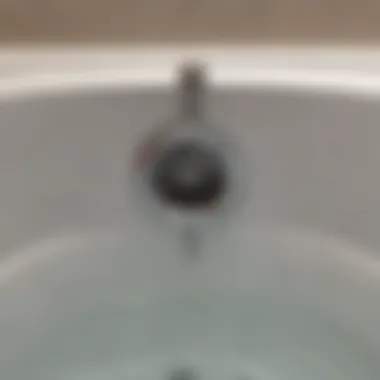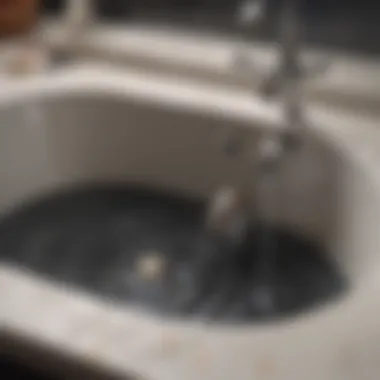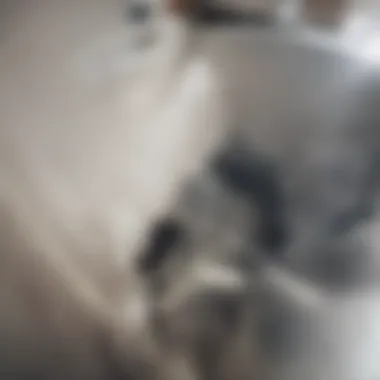Effective Strategies for Clearing a Slow Tub Drain


Intro
Dealing with a slow tub drain can be frustrating. It is not just an inconvenience; it can lead to bigger plumbing problems if not addressed quickly. Understanding how to clear a slow tub drain is essential for maintaining a clean and functional bathroom. There are various methods and preventative strategies to consider. This guide aims to provide practical solutions for both immediate clogs and long-term prevention.
Understanding Common Causes
To effectively address tub drain issues, identifying the root cause is crucial. Common culprits include:
- Hair Accumulation: Hair is the primary reason for slow drains in bathtubs.
- Soap Scum: Soap residue can build up over time.
- Mineral Buildup: Hard water can lead to mineral deposits clinging to pipes.
- Foreign Objects: Items like toys or personal care products sometimes get lodged in the drain.
Recognizing these factors can help in selecting the right clearing approach.
DIY Remedies to Try
Before calling a plumber, several simple techniques can be effective:
- Boiling Water: Pouring boiling water down the drain can often dissolve minor clogs.
- Baking Soda and Vinegar: This duo creates a reaction that can help break down buildup. Pour half a cup of baking soda, followed by half a cup of vinegar. Allow it to sit for 30 minutes, then flush with hot water.
- Wet/Dry Vacuum: If accessible, a vacuum can be used to suck out debris stuck in the drain. Ensure it is set to liquid and create a tight seal over the drain.
Importance of Regular Maintenance
Preventative measures matter as much as immediate actions. To avoid slow drains:
- Use Drain Covers: These can catch hair and debris before they enter the pipes.
- Regular Cleaning: Routine cleaning of the drain can minimize buildup.
- Be Mindful of What Goes Down the Drain: Educate household members about what can clog drains.
"An ounce of prevention is worth a pound of cure." Regular maintenance can save time and money in the long run.
More In-Depth Clearing Techniques
If DIY methods fail, more thorough techniques might be necessary:
- Plumber's Snake: A manual tool that can reach deep into pipes to clear stubborn clogs.
- Chemical Drain Cleaners: Use cautiously, as frequent use can deteriorate pipes. Always follow manufacturer instructions.
- Hydro Jetting: A professional can use high-pressure water to clear pipes fully.
Choosing a method depends on the severity of the blockage and personal comfort with each technique.
Knowing When to Call a Professional
Sometimes, clogs indicate larger plumbing issues. If water backs up in multiple fixtures, or if previous methods did not work, contacting a plumber is advisable. They have the expertise and tools to address complex situations that a homeowner might not manage effectively.
The End
Clearing a slow tub drain requires both immediate remedies and long-term care. Using the right techniques not only resolves current issues but also helps prevent future problems. Whether through simple DIY methods or consulting professionals, there are effective strategies to maintain a flowing tub drain.
Understanding the Problem of a Slow Tub Drain
Understanding why a tub drain slows down is crucial for maintaining a functional bathroom. A slow drain can lead to various issues, including unpleasant odors and potential water damage. By analyzing how drainage systems work and recognizing common signs, homeowners can tackle these problems efficiently before they escalate. Bringing awareness to these aspects helps in appreciating the significance of proper drain care. This article will equip readers with the knowledge needed to both address current slow drain issues and implement effective preventative measures.
The Mechanics of Drainage
Drainage in a tub operates through a system of pipes designed to remove wastewater effectively from the bathing area. When water enters the tub, gravity assists it in flowing down the drain, into a vertical pipe before it reaches the main plumbing system. If there is a partial obstruction, the water flow slows significantly, leading to a buildup of stagnant water.
Issues can arise from several factors. The diameter of the pipes plays a role; wider pipes allow for faster drainage. Proper venting is equally important. A blocked vent can create vacuum pressure, disrupting the flow and causing sluggish drainage. Understanding these mechanics allows one to pinpoint the exact nature of the slow drain, which is essential for selecting the most effective remedial method.


Common Signs of a Slow Drain
Detecting signs of a slow drain at an early stage is vital. Here are indicators that homeowners should watch for:
- Pooling Water: If water collects at the bottom of the tub rather than draining away, this is the most obvious sign of an issue.
- Gurgling Noises: Sounds emanating from the drain may suggest air trapped in the system due to a blocked vent.
- Slow Water Drainage: Noticeable delay in water levels dropping can be an early warning sign.
- Foul Odors: Stagnant water can lead to an unpleasant smell, indicating decay or bacteria buildup, warranting immediate attention.
Timely intervention can prevent larger problems that can arise from neglecting these signs.
Understanding these signs not only aids in quick action but also ensures the longevity of the plumbing system. Being vigilant can save time, effort, and cost in the future.
Identifying the Causes of Slow Drains
Understanding what causes a slow drain is crucial. When a bathtub drainage system fails to function properly, it leads to frustration and inconvenience. If a homeowner recognizes the specific causes, they can implement more effective solutions. Identifying the root of drainage issues prevents repeated problems and saves time and money in the long run. It's essential for anyone seeking to maintain a well-functioning plumbing system.
Hair and Soap Buildup
One of the most common culprits for slow bathtub drains is hair and soap buildup. Hair strands combined with soap scum create a sticky residue that can coat the insides of pipes. Over time, this accumulation restricts water flow. It is particularly prevalent in homes with long hair. Regular cleaning can mitigate this issue. Here are some practical steps to address hair and soap buildup:
- Use a drain catch: Installing a simple screen can prevent hair from entering the drain.
- Regular cleaning: Clean the screen and remove any buildup frequently.
- Cleaning solutions: Consider using a mixture of baking soda and vinegar once a month to dissolve soap scum.
Mineral Deposits
In many regions, water contains minerals. When hot water is used in the tub, these minerals start to develop deposits within the plumbing. Commonly seen in areas with hard water, mineral deposits can severely impede drain flow. This is especially true in older plumbing systems. Homeowners can combat this issue by:
- Using vinegar: Pouring vinegar down the drain can help break down mineral buildup.
- Regular maintenance: Schedule periodic checks with a professional to clean out the mineral deposits.
- Water softeners: Installing a water softener can reduce the number of minerals present in the water supply.
Foreign Objects
Items that inadvertently get stuck in the drain can also lead to slow draining. This can range from small toiletries to accidental drops of larger objects. Identifying and removing foreign objects is vital for maintaining clear drain flow. Here are a few tips:
- Be cautious: Avoid letting small items like soap boxes or hair accessories near the drain.
- Regular checks: Check the drain for any visible blockages.
- Plumbing snake: For deeper blockages, using a plumbing snake can help retrieve foreign objects.
Identifying these causes allows for targeted prevention and remediation efforts. A proactive approach ensures that your tub drain remains functional, enhancing overall home maintenance.
DIY Methods for Clearing Slow Tub Drains
Addressing a slow tub drain may seem daunting, but there are effective DIY methods available that can save time and costs. These techniques are not only accessible but also often utilize common household items. By using the right methods, homeowners can restore proper drainage efficiently. Additionally, these DIY solutions are environmentally friendly and reduce the need for harsh chemicals. Furthermore, many of these techniques offer preventive benefits that can help avoid future clogs, making them worthwhile for anyone seeking long-term solutions.
Boiling Water Technique
One of the simplest methods for clearing a slow tub drain is using boiling water. This technique is particularly effective for minor clogs caused by soap scum and grease buildup. To implement this method, first boil a kettle of water. Once it reaches a rolling boil, carefully pour the hot water directly down the drain in stages, allowing it to work on the clog.
In two to three increments, this approach helps break down blockages, especially in areas where grease might have solidified. As a precaution, it’s advisable to ensure that your plumbing can handle boiling water. This method may not suffice for severe clogs, but it’s an easy first step.
Using Baking Soda and Vinegar
Another popular DIY solution involves baking soda and vinegar. This combination creates a chemical reaction that can help dissolve clogs. Begin by pouring half a cup of baking soda directly into the drain. Follow this with a cup of vinegar. The mixture will fizz and bubble, which is normal. Allow it to sit for about 30 minutes, during which time it will work on dislodging the buildup.
After the allotted time, rinse the drain with hot water again. This technique not only helps clear minor blockages but also freshens up the drain. Regularly using this method can help prevent the formation of larger clogs in the future. Keep in mind that excessive use may not be advisable, as the reaction can become less effective over time.
Plunger Method
The plunger method is a classic approach that many rely on for clearing drains. A standard toilet plunger can also work on tub drains. First, ensure there is enough water in the tub to cover the plunger's cup. Position the plunger over the drain and maintain a firm grip on the handle. Push down slowly, ensuring a good seal before pulling up forcefully. Repeat this process several times. The suction created can dislodge blockages effectively.


If the clog is stubborn, more aggressive plunging may be necessary. However, caution is important; excessive force might damage the plumbing. This method is particularly useful for tougher clogs that other DIY methods might not resolve.
Plumbing Snake Application
For more challenging blockages, a plumbing snake proves useful. A plumbing snake, or auger, is a tool designed to reach deeper clogs. Start by inserting the snake into the drain. Rotate the handle to push the snake further into the pipe. When you encounter resistance, it’s likely the location of the blockage. Keep turning the handle until you feel the blockage break free.
Carefully pull the snake back out, and you may find hair or debris attached to it. Run hot water through the drain after this process to ensure any remaining debris is flushed away. While using a plumbing snake might require some skill, it is an invaluable tool in the arsenal of DIY solutions for slow drains.
Remember to always identify the nature of the clog before selecting a method. Understanding the type of blockage will guide you in choosing the most effective approach.
By implementing these DIY techniques, homeowners can address slow tub drains with confidence. Each method offers its unique benefits, allowing flexibility depending on the severity of the issue. Regular maintenance using these approaches not only resolves current problems but also promotes an efficient plumbing system.
Chemical Solutions for Drain Cleaning
Chemical solutions play a critical role in addressing slow tub drains, particularly when DIY methods do not yield satisfactory results. These products are designed to break down blockages effectively, providing a powerful alternative for homeowners. The convenience of chemical drain cleaners is a significant advantage. They can tackle stubborn clogs caused by various debris such as grease, hair, and soap scum. However, it is essential to consider their implications on both the environment and personal safety. Understanding how these cleaners operate, what types are available, and their potential hazards can guide you in making informed choices for your plumbing needs.
Overview of Chemical Drain Cleaners
Chemical drain cleaners can be classified mainly into three categories: caustic cleaners, acidic cleaners, and enzymatic cleaners.
- Caustic Cleaners: Often contain sodium hydroxide or potassium hydroxide. They are designed to produce heat to dissolve organic matter and are effective against grease and soap buildup.
- Acidic Cleaners: Typically contain sulfuric or hydrochloric acid. These are powerful and can break down tougher blockages but require careful handling.
- Enzymatic Cleaners: Utilize enzymes or bacteria to digest organic material slowly. They are safer for pipes and the environment but require more time to be effective.
Using the right type of cleaner is essential in effectively resolving drain issues while minimizing damage to pipes. Make sure to read the labels and follow the instructions carefully.
Environmental Considerations
Chemical drain cleaners can have a detrimental impact on the environment if not used responsibly. Many contain harmful substances that can seep into water systems, affecting aquatic life and overall ecosystem health. Here are a few points to keep in mind:
- Water Contamination: Harsh chemicals can pollute waterways. Trace amounts can enter the sewage system and potentially reach lakes and rivers.
- Recyclability: Many chemical containers are not recyclable and contribute to waste. It is wise to consider products with eco-friendly packaging.
- Alternatives: Explore greener alternatives to chemical cleaners when possible. Products labeled as biodegradable or made from natural ingredients often provide a safer solution for drain cleaning.
By taking the time to assess the environmental footprint of chemical solutions, you can make choices that are better for both your home and the planet.
Safety Precautions
When using chemical drain cleaners, safety should be the top priority. The effectiveness of these products can come at a cost if not handled properly. Here are some essential safety measures:
- Protective Gear: Always wear gloves and goggles to shield your skin and eyes from splashes and fumes. This is crucial for acidic and caustic cleaners.
- Ventilation: Ensure the area is well-ventilated. This helps reduce inhalation of harmful vapors, which can cause respiratory irritation or longer-term health issues.
- Do Not Mix Chemicals: Mixing different types of drain cleaners can cause dangerous reactions. Stick to one product at a time to avoid chemical burns or toxic fumes.
- Follow Instructions: Use the recommended amount as indicated on the package. Using too much product can lead to excessive heat buildup and potential damage to pipes.
Practicing these safety measures can make using chemical drain cleaners more streamlined and less hazardous, ensuring that you achieve a clear drain without compromising your well-being.
Preventative Measures for Drain Maintenance
Preventative measures are essential for maintaining a functional and clear drain. They not only protect against common issues but also enhance the overall longevity of the plumbing system. Engaging in proactive maintenance reduces the frequency of costly repairs and ensures that your drainage system operates effectively over time. Understanding and implementing these strategies is vital for both residential and commercial properties.
Regular Cleaning Practices
Cleaning your tub drain regularly is fundamental to preventing slow drain issues. A consistent schedule should be developed to address any potential buildup before it becomes problematic. This may include:
- Flushing the drain with hot water weekly to clear away minor debris.
- Using a drain-friendly cleaner or a simple mixture of baking soda and vinegar monthly.
By adopting such regular practices, you can effectively remove accumulated hair, soap scum, and other materials that impede drainage. Such habits not only sustain the functions of your drain but also keep unpleasant odors at bay.


Installation of Drain Screens
Installing drain screens is another key strategy for maintaining clear drains. Screens act as barriers, preventing larger debris, such as hair and soap, from entering the drainage system. They are relatively inexpensive and easy to install, making them a worthwhile investment. Some points to consider include:
- Select appropriate sizes: Ensure that the screen fits securely in the tub drain.
- Regularly clean the screen: Make it a practice to clean the screen weekly, discarding the trapped materials.
These small actions can prevent significant clogs, saving you time and money on future repairs.
Educating Household Members
Educating all household members about proper drain use is crucial. Knowledge sharing can significantly reduce the likelihood of drain issues. Consider the following:
- Communicate guidelines: Explain the importance of not flushing items like hair, paper products or grease down the drain.
- Create a drain maintenance routine: Encourage everyone in the household to adopt practices like cleaning the screens and reporting signs of slow drainage.
By fostering a culture of drain awareness, households can remain vigilant. This ensures everyone plays a part in maintaining a free-flowing tub drain, ultimately leading to a well-functioning plumbing system.
When to Call a Professional
In dealing with slow tub drains, there comes a time when the best course of action is to seek expert assistance. Recognizing when to call a professional plumber can save you from unnecessary frustration and potential damage. Sometimes, the methods discussed earlier may not yield results because the underlying issues are more complex than a simple buildup of hair or soap.
Issues within plumbing systems can escalate quickly. Addressing them in a timely manner often prevents larger problems that require more invasive repairs. Specifically, an expert can effectively diagnose issues that exceed the range of household remedies and tools. Here are the key aspects that highlight the importance of consulting a professional when dealing with slow drains:
- Expert Assessment: Professionals have the knowledge and experience to quickly identify the root cause of the blockage, whether it’s a simple clog or a deeper issue involving the plumbing system.
- Advanced Techniques: They utilize specialized tools, such as hydro-jetting or professional-grade snakes, which are more effective for certain types of blockages.
- Preventative Advice: An experienced plumber can not only resolve your immediate concerns but also provide advice on how to maintain your plumbing system in the future, reducing the likelihood of recurring problems.
Understanding the signs that indicate a professional is necessary is crucial for maintaining the health of your plumbing system.
Signs of Major Blockages
Not all slow drains signal a minor inconvenience. Some symptoms can indicate a larger issue that requires professional intervention. Recognizing these signs early can save you time and money:
- Gurgling Sounds: If you hear gurgling noises when draining water, this may suggest air getting trapped in the pipes, which can point to serious clogs.
- Multiple Drains Backing Up: When more than one drain in your home is slow, it can be a sign of a blockage further down in the plumbing system or in the main sewer line.
- Foul Smells: Unpleasant odors can indicate organic matter buildup that could produce more serious plumbing failures if not addressed.
- Frequent Clogs: If DIY methods only provide temporary relief and the problem persists, it’s time to seek a professional’s help.
Recognizing these signs can help you avoid potential damage and costly repairs.
Potential Structural Problems
In addition to blockages, slow drains can sometimes stem from structural issues within the plumbing system. These problems can be complex, requiring specialized knowledge to address them appropriately. Some common structural problems include:
- Broken Pipes: Cracks or breaks in pipes can cause leaks and pressure changes that lead to slow drainage. This necessitates professional inspection and repairs to prevent extensive damage.
- Root Intrusion: Tree roots can infiltrate sewer lines, causing significant blockages. Removal often requires the expertise of a plumber with experience in this specific issue.
- Pipe Misalignment: Over time, pipes can shift or sag, leading to blockages. Consulting a plumber can help determine if this is the case and whether repairs or reconstructions are necessary.
It's essential to be vigilant about the state of your plumbing. If you suspect any structural problems, reaching out to a plumbing expert can ensure a thorough evaluation and appropriate solutions.
Closure: Sustaining a Functional and Clear Drain
Maintaining a functional and clear drain is not just about resolving immediate issues. It involves understanding the intricacies of how your plumbing works and implementing strategies that promote longevity in your drainage system. By recognizing the signs of potential blockages and addressing them proactively, you can save yourself both time and money. This article has explored effective methods to clear slow tub drains while emphasizing the importance of routine maintenance.
Recapping Key Strategies
To ensure your tub drain operates smoothly, consider the following key strategies:
- Regularly clean your drains by removing debris and buildup. Implement simple household methods like using boiling water or natural cleaners like baking soda and vinegar.
- Install drain screens to catch hair and soap residues, preventing them from entering your pipes. This is a simple step that can greatly reduce clogging incidents.
- Check for foreign objects that may unintentionally fall into the drain. Being aware of what goes into your tub can greatly limit problems.
- Utilize chemical drain cleaners cautiously, only when necessary, and consider their environmental impact. It's essential to choose products that won't harm your plumbing or local ecosystems.
- Recognize when a professional is needed to prevent further damage. If you notice persistent slow drainage despite your efforts, it may indicate a more severe issue.
Encouraging Ongoing Maintenance
Ongoing maintenance is crucial for the health of your plumbing system. Here are some tips to encourage lasting practices at home:
- Set a cleaning schedule for your drains. This could be a monthly or quarterly routine where you check and clean your tub and adjoining drains. Consistency is key.
- Educate all household members about what can and cannot go down the drain. Awareness about items like grease, hair, and other waste can prevent blockages before they occur.
- Consider periodic professional assessments of your plumbing. A routine check can identify hidden issues before they turn into major problems, thus saving you from costly repairs.
- Prioritize drain health through mindful consumption of personal care products. Many soaps and shampoos contribute to buildup over time; choose biodegradable or less viscous options when possible.
By incorporating these strategies, you can ensure a well-functioning, clear tub drain, ultimately enhancing your home's plumbing longevity. Remember, prevention is generally easier and more cost-effective than treatment.







